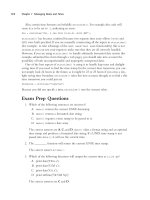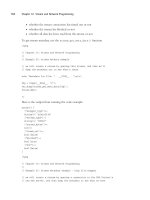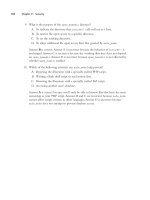Tài liệu Zend PHP Certification Study Guide- P4 pdf
Bạn đang xem bản rút gọn của tài liệu. Xem và tải ngay bản đầy đủ của tài liệu tại đây (194.41 KB, 20 trang )
44
Chapter 2 Object-Oriented PHP
The great advantage of inheritance is that it provides a simple mechanism for extend-
ing the capabilities of your code in a gradual way without having to rewrite loads of
code every time.
Magic Functions: Serializing Objects
You might sometimes want objects to be passed along between different calls to your
scripts—for example, from one page to the next. One way to do so is to use a process
known as “serialization” in which the contents of the object are saved and then the
object is re-created by reversing the process.
In PHP, this can be performed automatically by PHP by simply saving all the object’s
properties and then storing them back in the object when it is rebuilt. In some cases,
however, this is not what you might want. For example, one of your properties could be
a file resource—in which case, you would have to close the file when the object is serial-
ized and then open it again when it is unserialized.
In these instances, PHP can’t do the job for you, but you can implement two “magic”
functions to do whatever you need on an ad hoc basis:
<?php
class base_class
{
var $var1;
var $var2;
function base_class ($value)
{
$this->var1 = $value;
$this->var2 = $value * 100;
}
function calc_pow ($exp)
{
return pow ($var1, $exp);
}
function __sleep()
{
// Return an array that contains
// the name of all the variables to be saved
return array (‘var1’);
}
function __wakeup()
{
03 7090 ch02 7/16/04 8:45 AM Page 44
Please purchase PDF Split-Merge on www.verypdf.com to remove this watermark.
45
Exam Prep Questions
// Reconstruct $var2
$this->var2 = $this->var1 * 100;
}
}
?>
As you can see, the __sleep function is called whenever an object is serialized. It returns
an array that contains the names (minus the dollar sign) of all the data members that
must be saved. In our case, base_class::var2 is actually derived directly from the value
of base_class::var1, so we don’t want to save it.When the object is unserialized, the
interpreter will call __wakeup() in which we take the opportunity to rebuild $var2
with the appropriate value.
Exam Prep Questions
1. What will the following script output?
<?php
class a
{
var $c;
function a ($pass)
{
$this->c = $pass;
}
function print_data()
{
echo $this->$c;
}
}
$a = new a(10);
$a->print_data();
?>
A. An error
B. 10
C. “10”
D. Nothing
E. A warning
03 7090 ch02 7/16/04 8:45 AM Page 45
Please purchase PDF Split-Merge on www.verypdf.com to remove this watermark.
46
Chapter 2 Object-Oriented PHP
Answer D is correct.There actually is a bug in the print_data() function—
$this->$c is interpreted as a variable by PHP, and because the $c variable is not
defined inside the function, no information will be available for printing. Note
that if error reporting had been turned on, either through a php.ini setting or
through an explicit call to error_reporting(), two warnings would have been
outputted instead—but, unless the exam question tells you otherwise, you should
assume that the normal PHP configuration is being used. And in that case, the
interpreter is set not to report warnings.
2. When serializing and unserializing an object, which of the following precautions
should you keep in mind? (Choose two)
A. Always escape member properties that contain user input.
B. If the object contains resource variables, use magic functions to restore the
resources upon unserialization.
C. Use the magic functions to only save what is necessary.
D. Always use a transaction when saving the information to a database.
E. If the object contains resource variables, it cannot be serialized without first
destroying and releasing its resources.
Answers B and C are correct.Whenever you design an object that is meant to be
serialized or that can contain resource objects, you should implement the appro-
priate magic functions to ensure that it is serialized and unserialized properly—and
using the smallest amount of information possible.
3. What will the following script output?
<?php
error_reporting(E_ALL);
class a
{
var $c;
function a()
{
$this->c = 10;
}
}
class b extends a
{
03 7090 ch02 7/16/04 8:45 AM Page 46
Please purchase PDF Split-Merge on www.verypdf.com to remove this watermark.
47
Exam Prep Questions
function print_a()
{
echo $this->c;
}
}
$b = new b;
$b->print_a();
?>
A. Nothing
B. An error because b does not have a constructor
C. 10
D. NULL
E. False
Answer C is correct. Because the class b does not have a constructor, the construc-
tor of its parent class is executed instead.This results in the value 10 being assigned
to the $c member property.
03 7090 ch02 7/16/04 8:45 AM Page 47
Please purchase PDF Split-Merge on www.verypdf.com to remove this watermark.
03 7090 ch02 7/16/04 8:45 AM Page 48
Please purchase PDF Split-Merge on www.verypdf.com to remove this watermark.
3
PHP and the Web
Terms You’ll Need to Understand
n
Server-side
n
Client-side
n
Hypertext Transfer Protocol (HTTP)
n
GET request
n
POST request
n
Superglobal array
n
HTTP header
n
Cookie
n
Session
n
Session identifier
Techniques You’ll Need to Master
n
Distinguishing between server-side and client-side
n
Handling form data using superglobal arrays
n
Working with cookies
n
Persisting data in sessions
04 7090 ch03 7/16/04 8:44 AM Page 49
Please purchase PDF Split-Merge on www.verypdf.com to remove this watermark.
50
Chapter 3 PHP and the Web
Server-side Versus Client-side
One of the keys to understanding PHP’s role in the Web is to understand how the Web
works at a fundamental level.This generally involves a basic understanding of HTTP,
Hypertext Transfer Protocol.To examine the basic operation of the Web, consider a
typical HTTP client, your Web browser.When you visit a URL such as http://exam-
ple.org/, your browser sends an HTTP request to the web server at example.org.The
simplest example of this request is as follows:
GET / HTTP/1.1
Host: example.org
The web server’s responsibility is to respond to this request, preferably with the resource
that is desired (the document root in this example). An example of a response is as
follows:
HTTP/1.1 200 OK
Content-Type: text/html
Content-Length: 419
<html>
<head><title>Example Web Page</title></head>
<body>
<p>You have reached this web page by typing "example.com",
"example.net", or "example.org" into your web browser.</p>
<p>These domain names are reserved for use in documentation and are not
available for registration. See
<a href=” 2606</a>, Section
3.</p>
</body>
</html>
As you should notice, the majority of this response is the actual content, the HTML.
When your browser receives this response, it will render the web page (see Figure 3.1).
Once a page is rendered, you can disconnect your computer from the Internet, and this
won’t cause a problem until your browser needs to send another HTTP request.
Where does PHP fit into this process? PHP’s role is best explained as an aid to the
web server while it is generating the HTTP response.Thus, by the time the web server
sends the response, PHP’s job is done. Its output is included in the response. Because
PHP’s activity takes place on the server, it is an example of a server-side technology.
By contrast, any processing that takes place after the browser has received the response
is referred to as client-side. JavaScript is a popular choice for client-side scripting.You’re
probably familiar with using JavaScript or at least seeing it when you view the source of
a web page.This is a distinguishing characteristic.What you see when you view the
source of a web page is the content of the HTTP request.This content can be generated
on the server, so just as PHP can be used to generate HTML, it can also generate
JavaScript.
04 7090 ch03 7/16/04 8:44 AM Page 50
Please purchase PDF Split-Merge on www.verypdf.com to remove this watermark.
51
HTML Forms
Figure 3.1 A browser renders a web page.
JavaScript executes on the client.Thus, interacting with PHP is much more difficult
because it requires another HTTP request to be sent.After all, PHP’s job is done, and
the web server is quietly awaiting the next request. By the time JavaScript executes, there
isn’t even a connection between the Web client (your browser) and the web server any-
more.
If you find yourself having trouble determining whether you can pass data from PHP
to JavaScript or from JavaScript to PHP, it would be wise to review this section a few
times. A clear understanding of the environment in which PHP operates, and the dis-
tinction between client-side and server-side technologies, is important.
HTML Forms
One task with which you should already be familiar is processing HTML forms. Forms
provide a convenient way for users to send data to the server, and this makes the Web
much more interactive. PHP makes processing these forms easy for developers; the form
data is available in the
$_GET and $_POST superglobal arrays, depending on the method
used in the form (which in turn affects the request method used by the browser). In
addition, $_REQUEST is a method-agnostic array that you can use to access form data
(basically a merge of both $_GET and $_POST).
Superglobal arrays are available in every scope, which makes them convenient to use.
For example, you might use them in a function without having to declare them as glob-
al, and there is no need to ever pass them to a function.They are always available.
For versions of PHP prior to 4.1.0, you must use a different set of arrays because
$_GET, $_POST, and $_REQUEST are not available. Instead, you must use $_HTTP_GET_VARS
and $_HTTP_POST_VARS (for $_GET and $_POST, respectively).There is no equivalent for
$_REQUEST (where both arrays are merged), and these are also not superglobals, so you
must use them similar to standard arrays.
04 7090 ch03 7/16/04 8:44 AM Page 51
Please purchase PDF Split-Merge on www.verypdf.com to remove this watermark.
52
Chapter 3 PHP and the Web
To illustrate how form data is passed, consider the following form:
<form action=”/process.php” method=”post”>
<input type=”text” name=”answer” />
<input type=”submit” />
</form>
Figure 3.2 shows how this form appears in a Web browser.
Figure 3.2 A browser renders an HTML form.
If a user enters C for the answer and submits the form, an HTTP request similar to the
following is sent to the web server:
POST /process.php HTTP/1.1
Host: example.org
Content-Type: application/x-www-form-urlencoded
Content-Length: 8
answer=C
As a PHP developer, you can reference this value as $_POST[‘answer’] because the
request method (indicated on the first line of the HTTP request) is POST.
By contrast, if the method of the form specifies the use of a GET request, the request
is similar to the following:
GET /process.php?answer=C HTTP/1.1
Host: example.org
Rather than passing the form data as the content of the request, it is passed as the query
string of the URL. In this situation, you can reference $_GET[‘answer’] to get the
user’s answer.
04 7090 ch03 7/16/04 8:44 AM Page 52
Please purchase PDF Split-Merge on www.verypdf.com to remove this watermark.
53
HTML Forms
One important point about HTML forms is that the result of any form element is a
single name/value pair in the request.This is true for hidden form elements, radio but-
tons, checkboxes, and all other types. For example, consider the following form:
<form action=”/process.php” method=”post”>
<input type=”hidden” name=”answer” value=”C” />
<input type=”submit” />
</form>
Figure 3.3 shows how this form appears in a Web browser. Unlike the previous example,
the user is only presented with the submit button. As long as the user uses this form to
send the POST request, the value of $_POST[‘answer’] will always be C.The actual
request sent by the browser is identical to the previous example, thus it is impossible to
discern the type of HTML form used to generate a request by only observing the
request.
Figure 3.3 A browser renders an HTML form.
The behavior of some form elements can be confusing. Notably, elements such as check
boxes and radio buttons, because of their Boolean nature, are only included in the
request if selected.When selected, their value is determined by the value attribute given
in the HTML markup.Thus, the corresponding variable in PHP might or might not be
set, and you might want to use isset() on these types of elements to determine this.
There is also the special case in which multiple form elements are given the same
name, such as in the following example:
<form action=”/process.php” method=”post”>
<input type=”text” name=”answer” />
<input type=”text” name=”answer” />
<input type=”submit” />
</form>
04 7090 ch03 7/16/04 8:44 AM Page 53
Please purchase PDF Split-Merge on www.verypdf.com to remove this watermark.
54
Chapter 3 PHP and the Web
The browser will send a request similar to the following (assuming that the user answers
C and A, respectively):
POST /process.php HTTP/1.1
Host: example.org
Content-Type: application/x-www-form-urlencoded
Content-Length: 8
answer=C&answer=A
If you reference $_POST[‘answer’], you will notice that its value is A.Where did the
first answer go? As PHP processes the form for you and assigns variables within the
superglobal arrays, values can be overwritten. If this is not the desired behavior, there is a
simple naming convention you can use instead:
<form action=”/process.php” method=”post”>
<input type=”text” name=”answer[]” />
<input type=”text” name=”answer[]” />
<input type=”submit” />
</form>
By adding [] to the end of the form element name, you are asking PHP to create an
array for this particular element. Assuming that the same answers as before (C and A,
respectively) are entered before submitting the form, $_POST[‘answer’] is now an enu-
merated array, and the output of print_r($_POST[‘answer’]) is as follows:
Array
(
[0] => C
[1] => A
)
So, you now have both values preserved conveniently in an array.
Cookies
What are cookies? When described as entities, which is how cookies are often referenced
in conversation, you can be easily misled. Cookies are actually just an extension of the
HTTP protocol. Specifically, there are two additional HTTP headers: Set-Cookie and
Cookie.The operation of these cookies is best described by the following series of
events:
1. Client sends an HTTP request to server.
2. Server sends an HTTP response with Set-Cookie: foo=bar to client.
3. Client sends an HTTP request with Cookie: foo=bar to server.
4. Server sends an HTTP response to client.
04 7090 ch03 7/16/04 8:44 AM Page 54
Please purchase PDF Split-Merge on www.verypdf.com to remove this watermark.
55
Cookies
Thus, the typical scenario involves two complete HTTP transactions. In step 2, the serv-
er is asking the client to return a particular cookie in future requests. In step 3, if the
user’s preferences are set to allow cookies, and if the cookie is valid for this particular
request, the browser requests the resource again but includes the cookie.
Hopefully this simple explanation already makes it clear why you cannot determine
whether a user’s preferences are set to allow cookies during the first request.When you
set a cookie in your PHP code, whether by using setcookie() or header(), all you are
doing is modifying the HTTP response to include a Set-Cookie header.You cannot,
during the time that you are generating this response, determine how the browser will
react.After all, the browser won’t even receive the response (and the Set-Cookie header)
until PHP has finished executing.
The Set-Cookie header, at a minimum, contains the name and value of the cookie.
For example,
Set-Cookie: foo=bar
Other attributes can be included to modify when the cookie is to be sent in a subse-
quent request.These optional attributes are as follows:
n
domain—Restricts requests for which the cookie is sent to those that are within
the specified domain or in subdomains.The default is the domain of the current
resource.
n
expires—A date after which the cookie is no longer valid and should be deleted.
The default is to persist the cookie in memory only, expiring it as soon as the
browser ends.
n
path—Only requests for resources within the specified path include the cookie.
The default is no path restrictions.
n
secure—An attribute with no value that indicates that the cookie should only be
sent in requests sent over a secure connection, such as SSL.
An example of a Set-Cookie header with all optional attributes is as follows:
Set-Cookie: foo=bar; domain=example.org; expires=Mon, 26 Jul 2004 12:34:56 GMT;
➥ path=/; secure
The Cookie header included in subsequent requests contains only the name and value of
the cookie:
Cookie: foo=bar
The attributes included in the Set-Cookie header are only used to determine whether
the cookie should be included in the request at all. If included, only the name and value
are given. In PHP, cookies sent in the request are made available in the $_COOKIE super-
global array (for PHP versions prior to 4.1.0, cookies are available in the $_HTTP_
COOKIE_VARS array).
04 7090 ch03 7/16/04 8:44 AM Page 55
Please purchase PDF Split-Merge on www.verypdf.com to remove this watermark.
56
Chapter 3 PHP and the Web
Sessions
One common use of cookies, and one of the main reasons behind their inception, is to
maintain state. Stated differently, cookies allow you to associate separate HTTP transac-
tions together by identifying a specific client.
If you set a cookie with a unique identifier, you can store information about the
client on the server, and on the next request from that same client, you can use the
cookie to identify the client and fetch the data that you stored.This technique is known
as session management, and it relies on the ability to maintain state.
PHP makes all of this easy with its built-in sessions.To initiate PHP’s sessions, simply
include the following function call on any PHP page:
session_start();
If you are using the default php.ini, this function requires PHP to manipulate some
HTTP headers, so you must call it prior to any output. After you have called this func-
tion, you can simply use the $_SESSION superglobal array to store and access session
variables. (For PHP versions prior to 4.1.0, $_HTTP_SESSION_VARS must be used
instead.) For example, the following code sets a session variable named foo:
$_SESSION[‘foo’] = ‘bar’;
PHP takes care of propagating the session identifier (the unique identifier used to distin-
guish each client from any other) in a cookie or on the URL, depending on your
php.ini settings, and it also takes care of storing and retrieving the session data.
Quite a few directives in php.ini affect sessions.The most notable ones are as fol-
lows:
n
session.save_path—This indicates the directory in which PHP will store session
data.
n
session.use_cookies—This is a Boolean that indicates whether PHP will use
cookies to propagate the session identifier.
n
session.use_only_cookies—This is a Boolean that indicates whether PHP will
only check cookies for a session identifier (and not the URL).
n
session.name—The name of the session (also used as the name of the session
identifier).
n
session.auto_start—This is a Boolean that indicates whether PHP should
always enable session management, allowing you to avoid the call to
session_start().
n
session.cookie_lifetime, session.cookie_path, session.cookie_domain—
These correspond to the attributes used in the Set-Cookie header for the session
identifier.
04 7090 ch03 7/16/04 8:44 AM Page 56
Please purchase PDF Split-Merge on www.verypdf.com to remove this watermark.
57
Exam Prep Questions
n
session.use_trans_sid—This is a Boolean that indicates whether PHP should
dynamically choose whether to propagate the session identifier via cookies or the
URL, depending on the user’s preferences. If cookies are enabled, PHP will use a
cookie; otherwise, it will use the URL. On the first page, PHP will use both
methods since it cannot yet determine whether the user’s preferences allow cook-
ies (recall the previous discussion on cookies).
By default, PHP stores session data on the filesystem. If you want to modify this behav-
ior, you can create your own session-handling functions for opening, closing, reading,
writing, deleting, and garbage collection.To instruct PHP to use your functions for these
session-related tasks, use session_set_save_handler() as follows:
session_set_save_handler (‘myopen’, ‘myclose’, ‘myread’, ‘mywrite’, ‘mydelete’,
➥ ‘mygarbage’);
This gives you complete flexibility over the behavior of the session management fea-
tures, and you still use sessions the same way (session_start() and using $_SESSION).
Thus, any existing code that uses standard session features will still work as expected.
Exam Prep Questions
1. Is it possible to pass data from PHP to JavaScript?
A. No, because PHP is server-side, and JavaScript is client-side.
B. No, because PHP is a loosely typed language.
C. Yes, because JavaScript executes before PHP.
D. Yes, because PHP can generate valid JavaScript.
Answer D is correct. JavaScript, like HTML, can be dynamically generated by
PHP.Answers A and B are incorrect because the answer is yes.Answer C is incor-
rect because PHP executes before JavaScript.
2. Is it possible to pass data from JavaScript to PHP?
A. Yes, but not without sending another HTTP request.
B. Yes, because PHP executes before JavaScript.
C. No, because JavaScript is server-side, and PHP is client-side.
D. No, because JavaScript executes before PHP.
Answer A is correct.Although your instincts might lead you to believe that you
cannot pass data from JavaScript to PHP, such a thing can be achieved with anoth-
er HTTP request.Answer B is incorrect because PHP executing before JavaScript
is not what makes this possible.This is actually the characteristic that might lead
you to believe (incorrectly) that the answer is no.Answers C and D are incorrect
because the answer is yes, but also because the explanations given are false.
04 7090 ch03 7/16/04 8:44 AM Page 57
Please purchase PDF Split-Merge on www.verypdf.com to remove this watermark.
58
Chapter 3 PHP and the Web
3. Which types of form elements can be excluded from the HTTP request?
A. text, radio, and check box
B. text, submit, and hidden
C. submit and hidden
D. radio and check box
Answer D is correct.When not selected, both radio buttons and check boxes are
excluded from the HTTP request. Answer A and B are incorrect because text
boxes are always included in the request. Answer C is incorrect because hidden
form elements are always included.
4. When processing the form, what is the difference between a hidden form element
and a nonhidden one, such as a text box?
A. The hidden form element does not have a name.
B. There is no difference.
C. The hidden form element does not have a value.
D. The hidden form element is excluded from the request.
Answer B is correct.When processing a form, each form element is simply a
name/value pair within one of the superglobal arrays. Answers A and C are incor-
rect because hidden form elements can (and should) have both a name and a
value.Answer D is incorrect because hidden form elements are only excluded
from the user’s view, not from the HTTP request.
5. Which of the following form element names can be used to create an array in
PHP?
A. foo
B. [foo]
C. foo[]
D. foo[bar]
Answer C is correct. PHP will create an enumerated array called foo that contains
the values of all form elements named foo[] in the HTML form. Answers A, B,
and D are incorrect because any subsequent form elements of the same name will
overwrite the value in previous elements.
04 7090 ch03 7/16/04 8:44 AM Page 58
Please purchase PDF Split-Merge on www.verypdf.com to remove this watermark.
59
Exam Prep Questions
6. When an expiration date is given in a Set-Cookie header, what is the resulting
behavior in subsequent requests?
A. If the expiration date has expired, the cookie is not included.
B. The behavior is the same; the expiration date is included in the Cookie
header, and you can access this information in the $_COOKIE superglobal
array.
C. The cookie persists in memory until the browser is closed.
D. The cookie is deleted and therefore not included in subsequent requests.
Answer A is correct.Answer B is incorrect because only the name and value of the
cookie are included in the Cookie header.Answer C is incorrect because setting
an expiration date causes a cookie to either be deleted (if the date has expired) or
written to disk. Answer D is incorrect because the cookie is only deleted if the
date has expired, which isn’t necessarily the case.
7. If you set a cookie with either setcookie() or header(), you can immediately
check to see whether the client accepted it.
A. True, you can check the $_COOKIE superglobal array to see if it contains the
value you set.
B. True, but only if register_globals is enabled.
C. False, you can only use setcookie() if you need to test for acceptance.
Using header() does not work.
D. False, you must wait until you receive another HTTP request to determine
whether it includes the Cookie header.
Answer D is correct.The response that contains the Set-Cookie header is not sent
until PHP finishes executing, so you cannot test for acceptance prior to this.
Answers A and B are incorrect because the answer is false.Answer C is incorrect
because using setcookie() and header() both result in the same thing:A Set-
Cookie header is included in the response.
8. Why must you call session_start() prior to any output?
A. Because it is easy to forget if not placed at the top of your scripts.
B. Because you can no longer access the session data store after there has been
output.
C. Because session_start() sets some HTTP headers.
D. Because calling session_start() causes the HTTP headers to be sent.
Answer C is correct.Answer A is incorrect because this is a technical necessity, not
a best practice. Answer B is incorrect because accessing the session data store is
completely independent of whether there has been any output. Answer D is incor-
rect because you can set other HTTP headers after a call to session_start().
04 7090 ch03 7/16/04 8:44 AM Page 59
Please purchase PDF Split-Merge on www.verypdf.com to remove this watermark.
60
Chapter 3 PHP and the Web
9. Which of the following represents the proper way to set a session variable?
A. $_SESSION[‘foo’] = ‘bar’;
B. session_start();
C. session_set_save_handler (‘myopen’, ‘myclose’, ‘myread’,
‘mywrite’, ‘mydelete’, ‘mygarbage’);
D. $foo = $_SESSION[‘foo’];
Answer A is correct.Answer B is incorrect because session_start() only acti-
vates PHP sessions for the current script. Answer C is incorrect because
session_set_save_handler() allows you to override PHP’s default session
mechanism with your own custom functions. Answer D is incorrect; session data is
being used as the value of a regular variable and is not being manipulated in any
way.
10. Which of the following functions allows you to store session data in a database?
A. session_start();
B. session_set_save_handler();
C. mysql_query();
D. You cannot store session data in a database.
Answer B is correct.You can use session_set_save_handler() to override
PHP’s default session-handling functions and store session data any way you want.
Answer A is incorrect because session_start() only activates PHP sessions for
the current script. Answer C is incorrect because mysql_query() only executes a
query with MySQL and does not affect the behavior of PHP’s session mechanism.
Answer D is incorrect because this statement is false.
04 7090 ch03 7/16/04 8:44 AM Page 60
Please purchase PDF Split-Merge on www.verypdf.com to remove this watermark.
4
Arrays
AS MENTIONED BRIEFLY IN CHAPTER 1, “The Basics of PHP,” arrays are containers in
which an arbitrary number of other data elements can be stored. If you’re coming to
PHP from a language such as C, the concept of array that the former adopts will be a bit
different from what you’re used to.
Think of an array as a “collection” of heterogeneous values, each uniquely identified
by an arbitrary key, which can itself be either an integer numeric or string value.Thus,
for example, an array could contain a floating-point value, a string, a Boolean, and even
another array.
Although PHP will automatically provide a key for each value of the array if you
insert them sequentially, there doesn’t necessarily have to be any correlation between the
keys of each elements and the order in which they appear in the array—the first item
could have a key of “a string”, whereas the second could be 10, and so on.
Terms You’ll Need to Understand
n
Array
n
Key and value pairs
n
Numeric arrays
n
Associative arrays
n
Multidimensional arrays
n
Array navigation (or walking)
n
Sorting
n
Intersection and difference
n
Data serialization
05 7090 ch04 7/16/04 8:43 AM Page 61
Please purchase PDF Split-Merge on www.verypdf.com to remove this watermark.
62
Chapter 4 Arrays
Techniques You’ll Need to Master
n
Creating arrays
n
Handling numeric and associative keys
n
Creating and handling multidimensional arrays
n
Sorting arrays
n
Randomizing arrays
n
Intersecting arrays
n
Calculating the difference between one or more arrays
n
Serializing arrays
Creating Arrays
The simplest way to create an array is to use the array function:
<?
$a = array (
‘l’ => 10,
‘11’ => “test”,
‘another element’
);
var_dump ($a);
?>
The array construct makes it possible to create an array while specifying the keys and
the value of each pair that belongs to it, as well as the order in which they are added to
it. In the specific case shown previously, the resulting array, as outputted by var_dump()
will be as follows:
array(3) {
[“l”]=>
int(10)
[11]=>
string(4) “test”
[12]=>
string(15) “another element”
}
05 7090 ch04 7/16/04 8:43 AM Page 62
Please purchase PDF Split-Merge on www.verypdf.com to remove this watermark.
63
Creating Arrays
As you can see, the first element has a key of “l” and a value of 10.The second value
has a key of 11 even though we specified the string “11”.This is because PHP automati-
cally converts numeric strings into the corresponding integer value. Note that, unlike
what happens with string comparisons, a string value must actually be representable as an
integer in order to be converted automatically—thus, for example, the string “test”
does not create a key of 0.
The third value in the array has a key of 12 even though we did not specify one in
our call to array().This causes PHP to attempt and create a new key by itself by taking
the highest numeric key and adding one to it.There are, however, two exceptions to this
rule:
n
If the array doesn’t contain any element with a numeric key, an element with a
key of 0 is selected instead.
n
If the highest numeric key has a negative value, the new element will have a key
of 0. Note that is only true as of PHP 4.3.0—prior to that version, the new ele-
ment would have had a key equal to the highest numeric key plus one.
Using the Array Operator
The array operator [] is used to address an element of a particular array. For example,
<?
$a = array (
‘l’ => 10,
‘11’ => “test”,
‘another element’
);
echo $a[11];
?>
The expression $a[11] returns the element of the array $a with a key that can be inter-
preted as the integer number 11. Note that the array operator returns a reference to the
element, so you can actually use it to assign values to the element as well:
<?
$a[11] = ‘This is a test’;
?>
05 7090 ch04 7/16/04 8:43 AM Page 63
Please purchase PDF Split-Merge on www.verypdf.com to remove this watermark.









